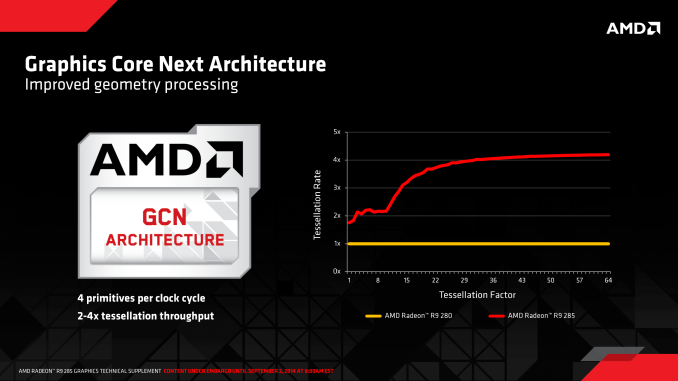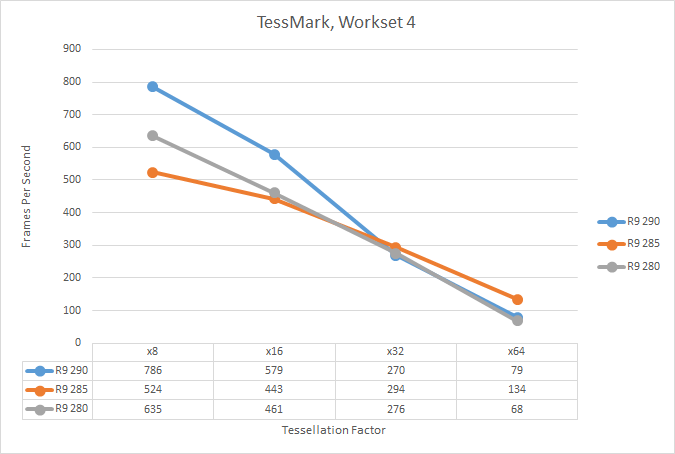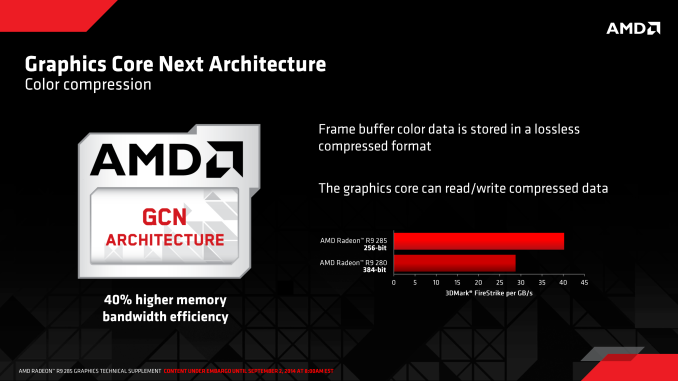AMD Radeon R9 285 Review: Feat. Sapphire R9 285 Dual-X OC
by Ryan Smith on September 10, 2014 2:00 PM ESTGCN 1.2: Geometry Performance & Color Compression
Instruction sets aside, Radeon R9 285 is first and foremost a graphics and gaming product, so let’s talk about what GCN 1.2 brings to the table for those use cases.
Through successive generations of GPU architectures AMD has been iterating on and improving their geometry hardware, both at the base level and in the case of geometry generated through tessellation. This has alternated between widening the geometry frontends and optimizing the underlying hardware, with the most recent update coming in the GCN 1.1 based Hawaii, which increased AMD’s geometry processor count at the high end to 4 processors and implemented some buffering enhancements.
For Tonga AMD is bringing that 4-wide geometry frontend from Hawaii, which like Hawaii immediately doubles upon Tahiti’s 2-wide geometry frontend. Not stopping there however, AMD is also implementing a new round of optimizations to further improve performance. GCN 1.2’s geometry frontend includes improved vertex reuse (for better performance with small triangles) and improved work distribution between the geometry frontends to better allocate workloads between them.
At the highest level Hawaii and Tonga should be tied for geometry throughput at equivalent clockspeeds, or roughly 2x faster than Tahiti. However in practice due to these optimizations Tonga’s geometry frontend is actually faster than Hawaii’s in at least some cases, as our testing has discovered.
Comparing the R9 290 (Hawaii), R9 285 (Tonga), and R9 280 (Tahiti) in TessMark at various tessellation factors, we have found that while Tonga trails Hawaii at low tessellation factors – and oddly enough even Tahiti – at high tessellation factors the tables are turned. With x32 and x64 tessellation, the Tonga based R9 285 outperforms both cards in this raw tessellation test, and at x64 in particular completely blows away Hawaii, coming close to doubling its tessellation performance.
At the x64 tessellation factor we see the R9 285 spit out 134fps, or equivalent to roughly 1.47B polygons/second. This is as compared to 79fps (869M Polys/sec) for the R9 290, and 68fps (748M Polys/sec) for the R9 280. One of the things we noted when initially reviewing the R9 290 series was that AMD’s tessellation performance didn’t pick up much in our standard tessellation benchmark (Tessmark at x64) despite the doubling of geometry processors, and it looks like AMD has finally resolved that with GCN 1.2’s efficiency improvements. As this is a test with a ton of small triangles, it looks like we’ve hit a great case for the vertex reuse optimizations.
Meanwhile AMD’s other GCN 1.2 graphics-centric optimization comes at the opposite end of the rendering pipeline, where the ROPs and memory controllers lie. As we mentioned towards the start of this article, one of the notable changes between the R9 280 and R9 285 is that the latter utilizes a smaller 256-bit memory bus versus the R9 280’s larger 384-bit memory bus, and as a result has around 27% less memory bandwidth than the R9 280. Under most circumstances such a substantial loss in memory bandwidth would result in a significant performance hit, so for AMD to succeed Tahiti with a smaller memory bus, they needed a way to be able to offset that performance loss.
The end result is that GCN 1.2 introduces a new color compression method for its ROPs, to reduce the amount of memory bandwidth required for frame buffer operations. Color compression itself is relatively old – AMD has had color compression in some form for almost 10 years now – however GCN 1.2 iterates on this idea with a color compression method AMD is calling “lossless delta color compression.”
Since AMD is only meeting us half-way here we don’t know much more about what this does. Though the fact that they’re calling it delta compression implies that AMD has implemented a further layer of compression that works off of the changes (deltas) in frame buffers, on top of the discrete compression of the framebuffer. In this case this would not be unlike modern video compression codecs, which between keyframes will encode just the differences to reduce bandwidth requirements (though in AMD’s case in a lossless manner).
AMD’s own metrics call for a 40% gain in memory bandwidth efficiency, and if that is the average case it would more than make up for the loss of memory bandwidth from working on a narrower memory bus. We’ll see how this plays out over our individual games over the coming pages, but it’s worth noting that even our most memory bandwidth-sensitive games hold up well compared to the R9 280, never losing anywhere near the amount of performance that such a memory bandwidth reduction would imply (if they lose performance at all).














86 Comments
View All Comments
CrazyElf - Wednesday, September 10, 2014 - link
All in all, this doesn't really change the market all that much.I still very firmly feel that the R9 290 right now (Q3 2014) remains the best price:performance of the mid to high end cards. That and the 4GB VRAM which may make it more future proof.
What really is interesting at this point is what AMD has to respond on Nvidia's Maxwell.
MrSpadge - Wednesday, September 10, 2014 - link
I Agree - Tonga is not bad, but on the other hand it does not change anything substantially compared to Tahiti. This would have been a nice result 1 - 1.5 years after the introduction of Tahiti. But that's almost been 3 years ago! The last time a GPU company showed no real progress after 3 years they went out of business shortly afterwards...And seing how AMD brags to beat GTX760 almost makes cry. That's the double cut-down version of a 2.5 years old chip which is significantly smaller than Tonga! This is only a comparison because nVidia kept this card at a far too high price because there was no competitive pressure from AMD.
If this is all they have their next generation will get stomped by Maxwell.
iLovefloss - Wednesday, September 10, 2014 - link
So all you got from this review is that Tonga is a cut down version of Tahiti? After reading this review, this is the impression you were left with?MrSpadge - Thursday, September 11, 2014 - link
Nope. But in the end the result performs just the same at even almost the same power consumption. Sure, there are some new features.. but so far and I expect for the foreseeable future they don't matter.Demiurge - Wednesday, September 10, 2014 - link
This is the first mid-range card to have all the value add features of the high-end cards. I wish AMD would leverage TrueAudio better, but the other features and the nice TDP drop.The color compression enhancement is a very interesting feature. I think that in itself deserves a little applause because of its significance in the design and comparing to the 280's. I think this is more significant, not as a performance feature, but similar to what Maxwell represented for NV in terms of efficiency. Both are respectable design improvements, in different areas. It's a shame they don't cross-license... seems like such as waste.
MrSpadge - Thursday, September 11, 2014 - link
Well, the TDP-drop is real, but mostly saves virtual power. By this I mean that 280 / 7950 never come close to using 250 W, and hence the savings from Tonga are far less than the TDP difference makes it seem. The average between different articles seems to be ~20 W saving at the wall and establishes about a power-efficiency parity with cards like GTX670.The color compression could be Tongas best feature. But I still wonder: if Pitcairn on 270X comes so close to 285 and 280 performance with 256 bit memory bus and without color compression.. how much does it really matter (for 285)? To me it seems that Tahiti most often didn't need that large bus rather than color compression working wonders for Tonga. Besides, GTX770 and GTX680 also hold up fine at that performance level with a 256 bit bus.
Demiurge - Thursday, September 11, 2014 - link
The TDP drop is something I did not think about being a paper launch value. You make a good point about the color compression too. It will be interesting how both fair. That may be an interesting topic to follow up during the driver refresh.As an owner of GTX 260 with a 448-bit bus, I can tell you that with anti-aliasing, it matters quite a bit as that becomes the limiter. The shader count is definitely not the limiter usually in the low-end and mid-range displays that these cards will typically be paired with. My GTX 260 and 1280x1024 monitor kind of illustrate that with 216 Shaders/896MB. :-)
It isn't pretty, but I don't see anything that forces me to upgrade yet. Think I've got two more generations or so to wait on before performance is significant enough, or a groundbreaking feature would do it. I'm actually considering upgrading out of boredom and interest in gimmicky features more than anything else at this point.
TiGr1982 - Thursday, September 11, 2014 - link
GTX 260 is like 6 years old now. It's lacking DX11, having less than 1 GB of (relatively slow) GDDR3 VRAM, and overall should be 3-4 times slower than R9 285 or R9 290, I guess.I really didn't think anybody still uses these old gen cards (e.g. I have HD 7950 Boost Dual-X which is essentially identical to R9 280).
P39Airacobra - Friday, January 9, 2015 - link
Because they would loose money! LOL. And they are both about the same anyway, Except AMD goes for brute force to get performance,(like using aV8) And Nvidia uses efficency with power. (Like a turbo charged 4cyl or 6cyl)bwat47 - Thursday, September 11, 2014 - link
"And seing how AMD brags to beat GTX760 almost makes cry. That's the double cut-down version of a 2.5 years old chip which is significantly smaller than Tonga! This is only a comparison because nVidia kept this card at a far too high price because there was no competitive pressure from AMD."You are being pretty silly here. Both AMD and Nvidia were rebranding a lot of cards these last few gens. You can'y go after AMD for rebranding a 2-3 year old chip, and then say its fine if nvidia does it and blame AMD's 'lack of competitive pressure'. If lack of competitive pressure was the reason for rebranding, then there was lack of competitive pressure on both sides.
And I highly doubt the 285 is 'all amd has'. this was just a small update to their product line, to bring some missing features (freesync, true audio etc...), and reduced power consumption to the 28x series. I'm sure there is a 3xx series coming down the road (or whatever they will call it). Both AMD and nvidia have been working been squeezing all they can out of older architecture for the past few years, you can't really put the blame on one of the other without being hypocritical.